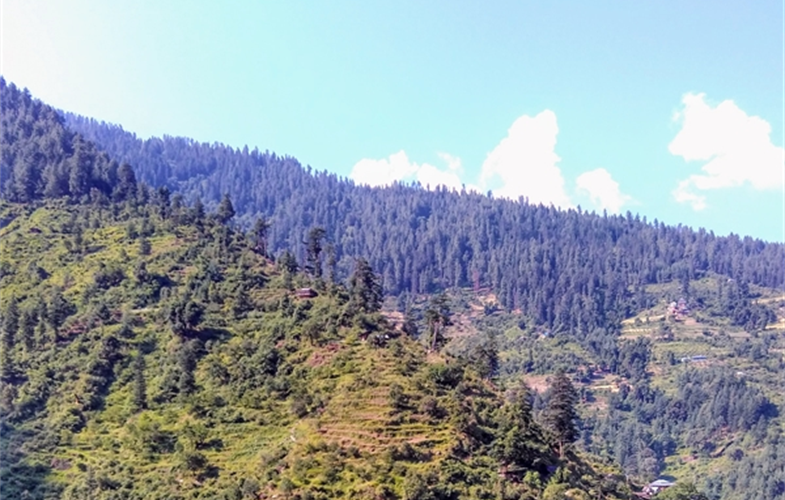Apr 27 2020
A new study by researchers at the Wildlife Conservation Society (WCS) shows that mountain-dwelling species that escape warming temperatures by moving to higher elevations might face decreased human pressure.
 Human pressure is often more intense at mountain bases, as in this Himalayan landscape in north India. Species shifting upslope tracking rising temperatures may find more intact habitats. Image Credit: Paul Elsen/WCS.
Human pressure is often more intense at mountain bases, as in this Himalayan landscape in north India. Species shifting upslope tracking rising temperatures may find more intact habitats. Image Credit: Paul Elsen/WCS.
The study published in the Nature Communications journal involved researchers at WCS, the United States Forest Service, and the University of California, Berkeley, and reveals that approximately 60% of all mountainous regions have been experiencing severe human pressure.
A majority of the pressure is at mountain bases and low elevations, places which are easier for people to survive, grow food, and construct roads.
The researchers made use of climate models to forecast the way species would get shifted under climate change. Based on their estimations, the team discovered that species move to higher elevations, which have more intact land for species due to less human pressure.
The researchers give a wake-up call that conservation actions might take the wrong course if human pressure is not taken into account. When human pressure is factored, the real “shape” of a mountain for species that are limited to intact landscapes can be obtained, as these species are often those at the biggest conservation concern.
In this context, the “true shape” relates to how much land area is possibly available for a species, and not just how much entire land area is available.
The true shape can divulge where species will tend to lose versus gain intact land area as they move due to climate change—the elevations at which species are predicted to lose area are the priority zones for conservation.
Mountains are a habitat of more than 85% of the world’s birds, mammals, and amphibians rendering them worldwide conservation priorities. However, mountain-dwelling species are at danger due to human activities—such as livestock grazing, agriculture, and development that decrease their habitat—and climate change that threatens to force the species to move up as they find it hard to locate tolerable temperatures.
Species are adapted to certain temperature conditions. As temperatures warm in mountains, scientists have documented species moving to higher elevations to maintain the same temperatures. This was always seen as a problem, because species would have less land area and less habitat to occupy at high elevations.
Paul Elsen, Study Lead Author and Climate Adaptation Scientist, Wildlife Conservation Society
Elsen continued, “But what we found is that as species move upslope, they tend to move away from areas that are already under intense human pressure and into areas with reduced human pressure. As a result, they can occupy more intact land area, even if the total amount of land area declines.”
Several global databases were combined by the researchers to make their evaluations. The high-resolution digital elevation models gave an idea about how much surface area is available at various elevations. The Human Footprint Index offered data on pressure due to human activities. Global climate models predicted how temperatures would probably vary by the late 21st century.
Additionally, the researchers made use of computer simulations to position hundreds of thousands of hypothetical “species” across the entire mountain ranges at various elevations and then projected how they would move their ranges depending on climate predictions.
For every simulation, the researchers first compared the total area the species had to the amount they would have following the shift in range under climate change.
We were surprised to find that many species had more intact land area available after the range shift compared to when they started.
Paul Elsen, Study Lead Author and Climate Adaptation Scientist, Wildlife Conservation Society
The outcomes of the study indicate that several species in mountain ranges might have a more intact land area available in the forthcoming days if they trace warming temperatures to higher slopes. However, exceptions were found.
Our results offer a glimmer of hope for montane species under climate change. Montane species are still facing tremendous human pressure, especially at low elevations, but we have the opportunity now to protect intact habitats at higher elevations to give these species the best possible chance going forward.
Paul Elsen, Study Lead Author and Climate Adaptation Scientist, Wildlife Conservation Society
The study titled “Topography and human pressure in mountain ranges alter expected species responses to climate change” was supported by the David H. Smith Conservation Research Fellowship, and financially supported by the Cedar Tree Foundation.
The authors of the study include Paul Elsen (Wildlife Conservation Society), William Monahan (US Forest Service), and Adina Merenlender (UC Berkeley).